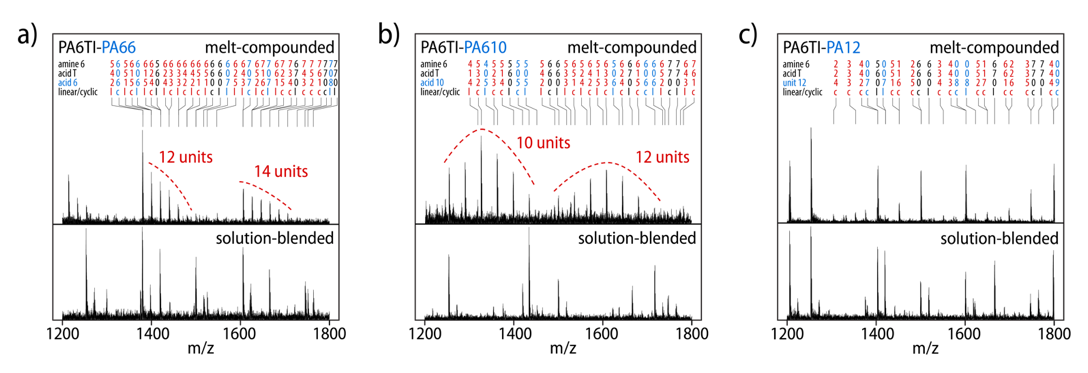High Temperature Copolyamides by Efficient Transamidation of Crystalline-Crystalline Polyamide Blends
High performance thermoplastic composites based on semiaromatic polyamides are prime candidates for metal replacement in lightweight structural applications. However, the low ductility and toughness of semiaromatic polyamides remain major obstacles to their wider industrial application. Here, we show that novel random copolymers are formed by the unexpectedly efficient transamidation during the melt compounding of semicrystalline semiaromatic with semicrystalline aliphatic polyamides. To this end, we melt-blended poly(hexamethylene terephthalamide-co-isophthalamide) (PA6TI) with different proportions of poly(hexamethylene adipamide) (PA66), poly(hexamethylene sebacoamide) (PA610) and poly(laurolactam) (PA12). In the case of the even-even polyamides PA66 and PA610, MALDI-TOF spectrometry confirmed random copolymers with PA6TI to be formed during melt compounding (Figure 1), resulting in homogeneous materials with single melting temperatures as well as glass transitions. A high degree of crystalline order was observed in these blends, as evidenced by differential scanning calorimetry and wide angle X-ray diffraction. By contrast, blends of PA6TI with the more hydrophobic and less hydrogen-bonded polyamide PA12 showed phase separation and a less efficient transamidation process. We propose that semicrystalline polyamides with compatible crystal structures, a high degree of hydrogen bonding and similar hydrogen-bonding show good initial compatibility and, therefore, undergo extensive transamidation. This opens the way to the systematic design and preparation of novel high performance thermoplastic polyamides by simple melt compounding.

Figure 1. MALDI-TOF spectra of semiaromatic PA6TI melt compounded with 50 wt% of aliphatic (a) PA66, (b) PA610 or (c) PA12, together with the corresponding reference spectra of the polymers solution-blended at room temperature. Peaks are assigned to the pure PA6TI (black), the pure aliphatic segments (blue), and copolymer segments consisting of a mixture of the two components (red). The observed distribution of mass peaks is hence consistent with extensive transamidation and randomization of the polymer sequence in the copolymers PA6TI-PA610 and PA6TI-PA66 resulting from melt compounding.